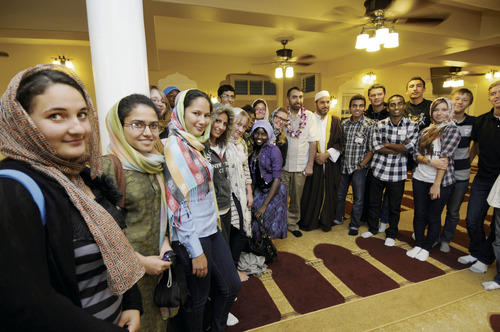Isles’ diversity holds lessons for students

Exchange students in the United States courtesy of State Department scholarships visited five churches, temples and synagogues as part of a religious diversity and leadership workshop. Among their stops was the Manoa Valley mosque with Hakim Ouansafi, head of the Muslim Association of Hawaii.
Hawaii’s diversity of ethnicities, religions and cultures had a profound effect on dozens of foreign exchange students who are completing a year of study in Hawaii high schools.
"I learned we’re all the same. Why do we fight over silly things? We are all interested in things that are right. We are all people calling for peace," said Alia Hijazi of Israel, one of 33 foreign exchange students who are here courtesy of State Department scholarships.
The Castle High School junior made those remarks after a tour by the group of five different houses of worship in Honolulu last week. The purpose was to show students the major tenets of each faith and, "most importantly, to realize that these religions have much in common," said Barbara Bancel, Hawaii-Alaska director of the Center for Cultural Interchange, a nonprofit group that helped place the students in schools and host families here.
The religious diversity workshop and a leadership seminar last Saturday wrapped up the exchange students’ year in Hawaii.
The exchange students are here under two State Department programs: the Youth Exchange and Study (YES) program, created a year after the Sept. 11, 2001, attacks to bring in exchange students from countries with significant Muslim populations; and the Future Leaders Exchange, which brings students from Eurasia, including former Soviet bloc countries, who are mostly nonaffiliated or of Christian Orthodox background, Bancel said.
"Hawaii’s wide diversity of ethnicities, religions and cultures had profound effects on their learning to be more open to differences, and tolerance and understanding of people who are just different," Bancel said.
Don't miss out on what's happening!
Stay in touch with breaking news, as it happens, conveniently in your email inbox. It's FREE!
Bancel said many students echoed Hijazi’s sentiments in written program evaluations, such as one who wrote, "I had never thought about how much Christianity, Judaism, and Islam have in common. It is almost as if they are all branches of one faith."
Another wrote, "Before I thought that my Christian church was the only good church. But, now I know that it is not so. I still love my church, but other churches are good, too!"
Bancel said the exchange program also provided "a wonderful and enriched learning environment for Hawaii students. Opportunities to meet students from all over the world and in particular from predominantly Muslim countries, counteracts negative feelings and ideas American students pick up through ignorance or lack of exposure. Most Hawaii kids have never met an Islamic student and believe they are all terrorists … until they become friends, fellow sports or debate or club participants at school."
Nadia Abulatif, a Muslim from the Palestinian territories who attended Castle and Radford high schools, said some local students asked her if she was a terrorist or knew Osama bin Laden. With that perspective, Abulatif said when she returns home, she plans to challenge anti-American stereotypes held by people there.
"Maybe I can’t change everybody’s mind, but I can at least change somebody’s mind and maybe that person will influence others, too," Abulatif said.
She and Hijazi became friends at Castle while they were new here and adapting to the Hawaii’s culture, language and student lifestyle.
"At the beginning it was hard for us to make friends" with local students, but Hijazi soon realized "if we kept staying together (exclusively), we will be missing out on the experience of being here. I started talking to other students and joined the tennis team and judo club. I made some friends after school."
Hijazi and Abulatif also gained a greater appreciation for each other’s backgrounds. Back home, Israeli Muslims like Hijazi are subject to prejudice by other Muslims "because they are considered traitors to the Muslim cause," Bancel said.
Hijazi said Abulatif’s friends back home asked, "Why are you talking to an Israeli? She (Abulatif) said, It doesn’t matter if she’s Israeli, she’s my friend.
"That’s why we’re here, to understand each other from different backgrounds. It was scary but we’ve done it — we’ve changed. We understand the world in a different way."
Sadman Mondalib of Bangladesh, who also attended Castle, said being a Muslim here presented no problems for him, though others at home warned him otherwise. He went to church with his host family and to its youth camp. "I didn’t think, ‘Oh, they’ll try to make me Christian,’" Mondalib said.
He plunged into extracurricular activities that included learning a Scottish accent for a part in the school musical "Brigadoon," his first chance to sing, dance and act.
"It was pretty amazing. I never experienced it before," he said. "I had ROTC practice, then I went to soccer practice, and after that I practiced dancing for three hours. I was half dead every single day. I always wanted to do this stuff back home, but there all I had to do was study.
"I had fun and a very busy eight months. I’m very thankful to God to make it happen. God gave me all that I wanted. I have a dream to come back to the U.S. and go to college."
Imam M. Bashar Arafat, a representative of the State Department’s Bureau of Educational and Cultural Affairs, came to Hawaii to address the students. During their visit to a mosque in Manoa Valley, he said, "We have to raise our voices (in the name of various religions) that the word of God has never condoned violence. It has always been to love your God, your neighbor and fellow human beings. … The words you see on a wall in a church, or temple or mosque — the word of God was always meant to bring us together, not to separate us."




